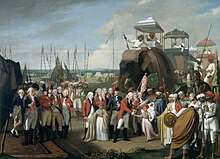Treaty of Seringapatam
Its signatories included Lord Cornwallis on behalf of the British East India Company, representatives of the Nizam of Hyderabad and the Maratha Empire, and Tipu Sultan, the ruler of Mysore.
The war broke out in late 1789 when Tipu Sultan, the ruler of the Kingdom of Mysore, attacked Travancore, an ally of the British East India Company.
[1] Rather than attempting to storm the works at great cost to all sides, Cornwallis entered into negotiations with Tipu to end the conflict.
Cornwallis had hoped to use the treaty as a wide-ranging peace settlement that would, in addition to reducing or removing the threat of Mysore, prevent conflict between Hyderabad and the Marathas.
The East India Company received a large portion of Mysore's Malabar Coast territories between the Kingdom of Travancore and the Kali River, and the Baramahal and Dindigul districts.

